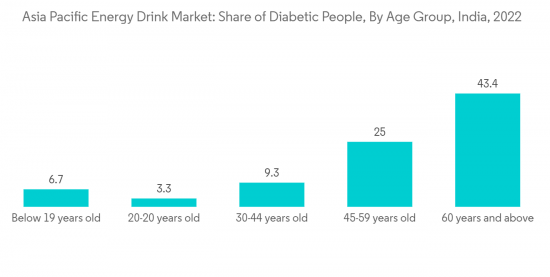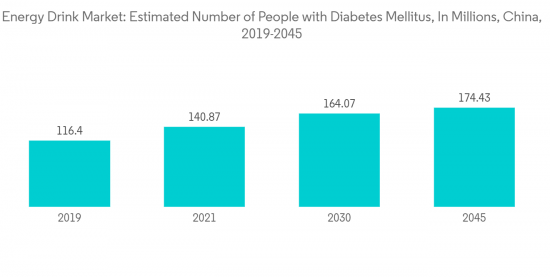PUBLISHER: Mordor Intelligence | PRODUCT CODE: 1326273

PUBLISHER: Mordor Intelligence | PRODUCT CODE: 1326273
Asia-Pacific Energy Drink Market Size & Share Analysis - Growth Trends & Forecasts (2023 - 2028)
The Asia-Pacific Energy Drink Market size is estimated at USD 16.23 billion in 2023, and is expected to reach USD 24.35 billion by 2028, growing at a CAGR of 8.46% during the forecast period (2023-2028).
The governments in the region have proactively responded to the situation to control the spread of COVID-19 through proper awareness, and efforts have been made to provide staples to all sections of the society in these disturbing times. This factor has rescued the energy drinks market from a huge crash. Thus, the market witnessed a surge in demand for products that provide immunity. Wunderman Thompson South Asia found that 94% of respondents from 32 cities in 15 states claimed that everyone in their home needed an immunity boost. The e-commerce platform Snapdeal claimed that a third of its users were buying safety and immunity-focused food and products.
Increased urbanization, rising disposable income, and growing health consciousness among consumers contribute to the rising demand for non-carbonated drinks across the Asia-Pacific market. Adolescents widely consume energy drinks due to their claims to improve performance, endurance, and alertness. At the same time, long and erratic working hours and the increasing occurrence of social gatherings are driving consumers toward the consumption of energy drinks.
Moreover, energy drinks with lower sugar content and natural ingredients are set to boom and continue to attract a greater number of health and wellness concentric consumers' attention. For example, brands containing natural ingredients extracted from products such as coffee beans are expected to propel in the region. The energy drinks market is also projected to grow due to an increase in the promotional and advertisement strategies by various manufacturers operating in the market. However, strict regulations set by governments in various countries in the region may hinder the growth of the market studied.
Asia-Pacific Energy Drink Market Trends
Growing Consumer Inclination Toward Low Sugar Beverages
The growing demand for low-sugar energy drinks is an increasing health concern among consumers. The high sugar content in traditional energy drinks has been linked to several health issues, including obesity, diabetes, and heart disease. Due to the high prevalence of diabetes in the region, consumers are becoming more aware of the importance of a healthy diet and an active lifestyle. For instance, according to GOQii, 13.2% Indian population was diabetic last year. Owing to the rising health concerns and the increasing measures to prevent the occurrence of lifestyle diseases, consumers are opting for low-calorie, low-sugar, or sugar-free dietary patterns in foods and beverages. Consumers prefer natural sweeteners, such as stevia, in their beverages. Companies like PepsiCo Inc. and Coca-Cola are committed to removing artificial ingredients and reducing the sugar content in their products.
Moreover, changes in consumer preferences for reduced or no-sugar products directed beverage manufacturers toward product innovation. These manufacturers are developing a range of novel products to meet the accelerating demand for such products, as consumers are actively trying to avoid consuming sugary drinks to prevent the harmful effects of excessive sugar intake. A similar approach was followed by energy drinks companies like Red Bull, which expanded its product portfolio to cater to the demands of health-conscious consumers. For instance, in July 2022, Coca-Cola India introduced low, zero-sugar variants of its sparkling brands.

China Holds the Largest Market Share
The demand for functional beverages is gradually increasing in China. However, especially energy drinks, which already make up most of the functional beverages, are growing rapidly. This is due to factors such as rapid urbanization that have been in the process of converting a large population into urban dwellers. The rising income and disposable income levels and constant improvement of living standards of people in the country have resulted in modernized, busier lifestyles, which is one of the primary drivers of the increase in demand. Canned and bottled energy drinks are now sold in all retail outlets in China, from supermarkets and hypermarkets to convenience stores and online, thereby boosting the sales of the products in the country. Additionally, increasing advertisement and promotional activities influence the demand for energy drinks from different consumer groups. Social media has become very influential in purchasing behavior of Chinese consumers. Hence, the increasing promotions, including advertisements for energy drinks on various media channels, are gaining customers' attention in the country.
Market players are also experimenting with natural ingredients within their portfolios to meet the energy, taste, and size requirements of the ever-evolving consumers in the country. Brands are coming up with new flavors to compete with existing competition. Thus all such factors are anticipated to support the demand and consumption of energy drinks in the Chinese market over the coming years. Moreover, major players such as 5-Hour Energy and PepsiCo Inc. are continuously focusing on product innovation and expansion strategies to further boost the growth of the energy drinks market in China. For instance, the original inventor of the Red Bull brand accelerated its presence in China with an investment of USD 150 million.

Asia-Pacific Energy Drink Industry Overview
Energy drink players in the Asia-Pacific region have started to increase their levels of marketing and advertising activities to maintain consumer demand for the beverages. The Asia-Pacific energy drink market is a consolidated market with a significant share held by leading players like Red Bull GmbH, Dali Foods Group, PepsiCo Inc., Osotspa Public, Company Limited, LT Group Inc., Carabao, and Tawandang Co. Ltd. Energy drinks claim a major market share, especially among the young population in Asian countries. The use of natural ingredients in energy drinks and the growth in new varieties and types of energy drinks are the primary drivers for the growth in the market. In addition, energy drinks are increasingly being used as mixers for alcoholic beverages. This trend is more commonly observed among the younger population in the age group of 18-34 years.
Additional Benefits:
- The market estimate (ME) sheet in Excel format
- 3 months of analyst support
TABLE OF CONTENTS
1 INTRODUCTION
- 1.1 Study Assumptions and Market Definition
- 1.2 Scope of the Study
2 RESEARCH METHODOLOGY
3 EXECUTIVE SUMMARY
4 MARKET DYNAMICS
- 4.1 Market Drivers
- 4.2 Market Restraints
- 4.3 Porter's Five Forces Analysis
- 4.3.1 Threat of New Entrants
- 4.3.2 Bargaining Power of Buyers/Consumers
- 4.3.3 Bargaining Power of Suppliers
- 4.3.4 Threat of Substitute Products
- 4.3.5 Intensity of Competitive Rivalry
5 MARKET SEGMENTATION
- 5.1 By Product Type
- 5.1.1 Drinks
- 5.1.2 Shots
- 5.1.3 Mixers
- 5.2 By Distribution Channel
- 5.2.1 Supermarkets/Hypermarkets
- 5.2.2 Food Services
- 5.2.3 Online Retail
- 5.2.4 Specialist Stores
- 5.2.5 Other Distribution Channels
- 5.3 By Geography
- 5.3.1 India
- 5.3.2 China
- 5.3.3 Japan
- 5.3.4 Australia
- 5.3.5 Rest of Asia-Pacific
6 COMPETITIVE LANDSCAPE
- 6.1 Most Adopted Strategies
- 6.2 Market Share Analysis
- 6.3 Company Profiles
- 6.3.1 Tan Hiep Phat Group
- 6.3.2 Dali Foods Group
- 6.3.3 Osotspa Public Company Limited
- 6.3.4 PepsiCo Inc
- 6.3.5 Monster Beverage Corporation
- 6.3.6 Red Bull GmbH
- 6.3.7 The Coca-Cola Company
- 6.3.8 Carabao Tawandang Co. Ltd
- 6.3.9 5-Hour Energy
- 6.3.10 Globe Group
- 6.3.11 LT Group Inc.
- 6.3.12 Otsuka Holdings
7 MARKET OPPORTUNITIES AND FUTURE TRENDS




